Weighted vests are everywhere these days—at the gym, on hiking trails, even in TikTok videos where influencers promise they’ll improve posture, burn calories, and strengthen bones and muscles. However, experts warn that not all the claims hold up under scientific scrutiny.
Researchers in exercise science say the evidence for weighted vests and bone or muscle health is weak. While they agree that adding weight to walking or running can raise calorie burn and cardiovascular demand, the research so far does not show significant benefits for bone density or muscle growth.
Lauren Colenso-Semple at McMaster University and OB-GYN Monica Christmas in Chicago both suggest more proven forms of resistance training if building strength is the goal.
What weighted vests actually do
A weighted vest is a garment with evenly distributed weights that adds load to daily activity or workouts. People often use them during walking, running, or bodyweight movements to make exercise feel harder and, in theory, more effective. Some influencers even market them as tools for women in perimenopause and menopause, when bone density naturally declines.
But the science is less convincing than the hype. Colenso-Semple points to limited studies, some showing no measurable difference in bone health between walkers with or without a vest. Another trial noted small gains when weighted vests were used alongside resistance workouts, though it was unclear whether the vest itself made the difference. “When we actually look at the data, it really doesn’t support the use for that”, she explains.
Muscle growth requires stressing fibers through a full range of motion with meaningful resistance, like squats, lunges, or curls with weights. Walking, even with a vest, doesn’t create enough of that stimulus. That’s why experts recommend weight-bearing exercises, Pilates, or balance training over investing in a vest if bone or muscle strength is the priority.
Wearing weighted vests: Nuances and the bottom line
Weighted vests aren’t entirely without value. Roger Fielding, an exercise scientist at Tufts University, notes that wearing one can increase oxygen consumption, heart rate, and calorie burn, all of which support cardiovascular fitness. For someone trying to make a routine walk more challenging, a vest could be motivating. Some people also report simply enjoying the feeling of training with extra weight.
Still, experts caution against seeing vests as a substitute for proven strategies. Monica Christmas emphasizes strength training with actual weights as a more effective use of time and money. Nanette Santoro, an OB-GYN in Colorado, adds that too many products are marketed to women in menopause with promises not backed by research, creating more confusion than help.
Weighted vests don’t deliver the bone and muscle benefits that social media often claims. They may make walks more intense and help burn a few extra calories, but they’re no replacement for lifting weights, practicing resistance training, or doing balance exercises. For those who enjoy them, they’re safe and can be part of a fitness routine. But if the goal is stronger bones and muscles, the science is clear: stick with resistance work.

